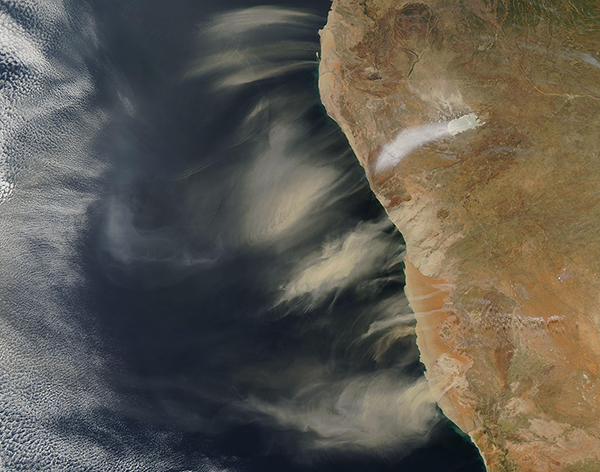Images
July 13, 2023 - Dust and Salt off the Coast of Nambia
Tweet
Fierce winds drove sheets of dust from the Namib Desert over the South Atlantic Ocean in mid-July 2023.
On July 11, when the Moderate Resolution Imaging Spectroradiometer (MODIS) on NASA’s Aqua satellite acquired this true-color image, winds were particularly strong. Not only were they carrying widespread and thick tongues dust, but a broad plume of minerals (primarily salt) was lofted from the Etosha Pan and carried to the Atlantic Coast.
On that same day, a post on the Namibia Weather Forecast Facebook page described the scene in Walvis Bay, which is a coastal city located on the Kuiseb River delta just north of the orange sands of the Namib Desert. The post read, in part, “morning in Walvis Bay was frustrating for many residents, as they had to continuously sweep away sand from their homes and businesses. The sand encroachment seemed unstoppable, and people resorted to innovative measures such as using empty plastic bags to seal openings and protect their homes.” Local media in Arandis, a town near the north-central coast, reported a fatality from a traffic accident that was caused by extremely poor visibility. Wind speeds of about 50 kilometers per hour (31 mph) were reported in several locations.
The intense winds responsible for the shifting sand and salt are known as “berg winds”—hot, dry northeasterly or east winds that sweep down from inland mountains and plateaus, lofting dust and fine sediments into the air and carrying them across the coastal plain. Locally, this weather is said to be called the "Oosweer" (East Weather). In some locations, it also carries the nickname “The Doctor,” because it is thought that the heat and extreme dryness of these winds help dry out homes, cupboards, closets, pavement, and public places, effectively disinfecting them from germs that tend to thrive in wet, foggy winter weather.
Image Facts
Satellite:
Aqua
Date Acquired: 7/11/2023
Resolutions:
1km (2 MB), 500m (4.4 MB),
Bands Used: 1,4,3
Image Credit:
MODIS Land Rapid Response Team, NASA GSFC
Tweet
Fierce winds drove sheets of dust from the Namib Desert over the South Atlantic Ocean in mid-July 2023.
On July 11, when the Moderate Resolution Imaging Spectroradiometer (MODIS) on NASA’s Aqua satellite acquired this true-color image, winds were particularly strong. Not only were they carrying widespread and thick tongues dust, but a broad plume of minerals (primarily salt) was lofted from the Etosha Pan and carried to the Atlantic Coast.
On that same day, a post on the Namibia Weather Forecast Facebook page described the scene in Walvis Bay, which is a coastal city located on the Kuiseb River delta just north of the orange sands of the Namib Desert. The post read, in part, “morning in Walvis Bay was frustrating for many residents, as they had to continuously sweep away sand from their homes and businesses. The sand encroachment seemed unstoppable, and people resorted to innovative measures such as using empty plastic bags to seal openings and protect their homes.” Local media in Arandis, a town near the north-central coast, reported a fatality from a traffic accident that was caused by extremely poor visibility. Wind speeds of about 50 kilometers per hour (31 mph) were reported in several locations.
The intense winds responsible for the shifting sand and salt are known as “berg winds”—hot, dry northeasterly or east winds that sweep down from inland mountains and plateaus, lofting dust and fine sediments into the air and carrying them across the coastal plain. Locally, this weather is said to be called the "Oosweer" (East Weather). In some locations, it also carries the nickname “The Doctor,” because it is thought that the heat and extreme dryness of these winds help dry out homes, cupboards, closets, pavement, and public places, effectively disinfecting them from germs that tend to thrive in wet, foggy winter weather.
Image Facts
Satellite:
Aqua
Date Acquired: 7/11/2023
Resolutions:
1km (2 MB), 500m (4.4 MB),
Bands Used: 1,4,3
Image Credit:
MODIS Land Rapid Response Team, NASA GSFC




